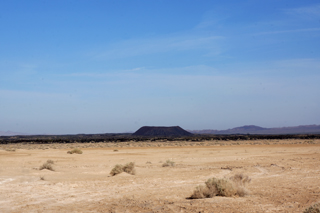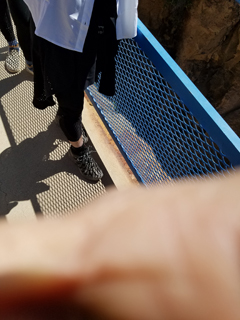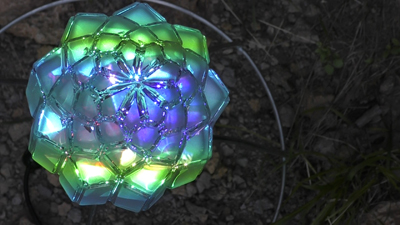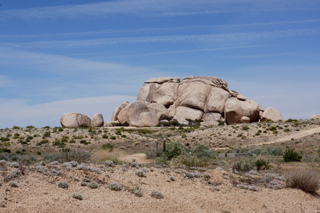
Amboy Road to the east of Twentynine Palms extends into the Mojave Desert through a landscape of failed homes punctuated occasionally with a residence of the living. Amboy Road heads north past Amboy Crater, an extinct volcanic cinder cone, crosses the railroad tracks then arrives at the town of Amboy on 'the' route 66.

North of Amboy is Mojave National Preserve. Hole in the Wall is a park inside of the Mojave National Preserve. Seas of sand dunes, volcanic cinder cones, Joshua tree groves, and meadows of wildflowers. A 1.6 million acre park. Canyons, mountains and mesas hide long-abandoned mines, reveal homesteads and rock-walled military outposts. A video animation of a manStandingWithGolfClub is projected into a glass lamp shade mounted upside down over a metal frame. The light is fractured. A kaleidoscope.

A 2" x 2" Insignia projector sits on the ground under the glass lamp shade inside the metal frame. The Insignia projector has no memory or video player capabilities. A miniHD media player is needed to play the .mp4 animation. The miniHD media player requires a AA battery pack for power. When projected inside the art deco frosted glass lampshade the video manStandingWithGolfClub is broken up by the slanted planes of the glass so the figure is no longer discernible. It becomes a pattern of colors.

The rock formations at Hole in the Wall were created by eruptions which spewed layers of lava and ash over this area. Uneven cooling and gases captured during the eruption, formed "holes " in the rock. Over time these holes have enlarged due to wind and water erosion. There are trails with metal walkways and fences cut through the rock cliffs .

Black Canyon Road is a dirt road which leaves Hole in the Wall and winds through joshua trees and deadwood until it connects up with the main highway which crosses the park. Spewn alongside Black Canyon Road are piles of granite rocks which appear to have been dumped over the landscape. A roadside sign warns of flash flooding.